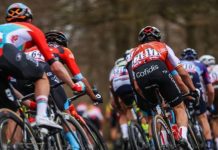BMW Group automobiles are usually trimmed for maximum efficiency and dynamics in the aerodynamic test centre. These days, however, a rather unusual object is the focus of the BMW engineers’ aerodynamic analyses: a catamaran.
It is in the state-of-the art wind tunnel at the BMW Group Research and Innovation Center (FIZ) that the foundations are to be laid for success in one of the most technologically-demanding sporting competitions in the world: the America’s Cup.
ORACLE TEAM USA, Defender of the 35th America’s Cup, has won the prestigious trophy the last two times and now has its sights set on a hat-trick of titles. It takes on this latest mission alongside Technology Partner BMW – a combination that tasted success together in 2010 in Valencia Spain, when the team first won the oldest trophy in international sport.
“This time, the engineers are faced with new challenges,” says Holger Gau, BMW expert in 3D simulation methods: “The America’s Cup Class catamarans fly on their foils, spending the majority of their time virtually completely out of the water. This is spectacular for the spectators, physically demanding for the crews, and means that we engineers and designers must focus our efforts on finding that decisive advantage in terms of speed: the hydrodynamics of the hull hardly play a role any more. Aerodynamics are more important to us.”
Because of this, it is no wonder that the Munich-based automobile manufacturer’s aerodynamic test centre and the expertise of the BMW specialists will play a key role when designing the racing yachts for ORACLE TEAM USA.
“BMW is a company, whose success is based on innovative engineering. It is a leader when it comes to pioneering technology,” said Grant Simmer, the team’s Chief Operating Officer. “The cooperation on the America’s Cup victory in 2010 showed just how valuable this expertise can be in the field of boat design. We are now laying the foundations for 2017, and we can consider ourselves fortunate to have BMW on our side.”
BMW’s aerodynamics experts are working on precisely this basis. “We are currently performing intensive aerodynamic tests on a model of the current yacht design. This will provide us with reliable reference data to compare to in-depth CFD research that is planned,” explained Gau.
“Up until the America’s Cup match in June 2017, the priority will be to test the effectiveness of any ideas for optimising the design, as well as many detailed changes: Do they have the desired effect? How do they affect the complex aerodynamic interaction between the hull, the platform, the wing sail, and the positioning of the crew on board? We need to gather comprehensive data, as any little nuance could be decisive – particularly as the design of the larger parts of the platform, particularly the hull, are stipulated in the rules. Therefore, the designers do not have all that many adjustable screws that they can turn.”
BMW is perfectly familiar with these challenges, particularly from the company’s motorsport commitments. Here too, the regulations are very stringent, making it all the more essential to be as creative as possible with the aerodynamic leeway they have.
One of the few components of the platform of an America’s Cup Class catamaran that can be freely designed is the fairing of the cross beam between the hulls – the area, into which the apparent wind flows (the sum of the true wind and the induced wind). The optimal airflow over the entire object starts precisely here and is crucial to any aerodynamic optimisation – another parallel to automobile design and motorsport.





































